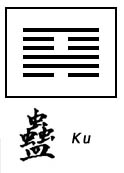
Wind supports the Mountain
by Chuan Jing Shakya, OHY
Presented July 15, 2000
A reader from Dallas writes: "I've been away from Karate for a long time. I'm no kid anymore and I'm completely out of shape. Is it worth running the risk of injury by getting back into it?"
I'll use as my text Hexagram #18 of the I Ching, Ku. "Work on what has been spoiled. (Decay)" This is "Wind supports the Mountain." Ken over Sun: Mountain (keeping still) over Wind (the gentle). 
In the sixth century A.D. a Buddhist monk, a prince named Arya Bodhidharma, arrived in China to introduce a new form of Buddhism, one that existed outside of the sutras: Chan Buddhism.
Eventually coming to reside at Shaolin Temple, Bodhidharma observed that the majority of monks in the temple were in poor health. He saw immediately that they were in such poor condition because they were spending so much time sitting in "still" meditation. The monks had meditated to the point of neglecting their physical health.
In an effort to correct the problem, Bodhidharma presented the monks with various sets of exercises which involved coordinating bodily movements with the mind and breath.
The exercises were a new way for the monks to meditate and pray. In fact, with the new exercises, the more that a monk prayed and meditated, the stronger he became. Bodhidharma did not abandon standard meditation, breathing techniques and spiritual practices in the daily regimen. He included them; and by the gradual introduction of physical exercises, he blended many powerful techniques together so that the monks could attain Liberation and great power over their mind and body. This union of Chan meditation and physical exercise allowed for the development of a very high level of practice: Kung Fu. This powerful, spiritual kung fu was in every way beneficial. It heightened a monk's spiritual state as it developed his physical prowess as a martial artist. Shaolinji's reputation as a center for this new kung fu style grew, attracting more martial artists to come and learn the monks' methods. This eventually led to the inclusion of wisdom from many sources, further enhancing the efficacy of the Shaolin program.
In its purest form Shaolin kung fu is moving prayer. Through practice the mind, body and breath are conditioned and strengthened. When these three aspects are strong enough, they can be united into one energy. This single pointed energy may be used to expand awareness and attain to higher states of existence.
The hexagram Ku from the I Ching presents the image of a mountain over a gentle penetrating wind.
Some styles of martial arts are obviously more rigorous and physically risky than others. It is one thing to begin these arts as a young, strong, resilient student. It's another thing altogether to try to resume them after years of neglect. A more gentle approach or re-introduction is needed, one that will be consonant with the practitioner's spiritual regimen. That which has been spoiled through man's efforts can be made good again through man's work. When Bodhidharma created the temple exercises he provided the monks of Shaolin with the means through which they could rejuvenate their bodies with the power of energetic meditation. And it is this idea of reversing the decay process by gentle means that ought to be considered when resuming a martial arts' practice.
Please feel free to email me with any comments or questions. cjs@hsuyun.org